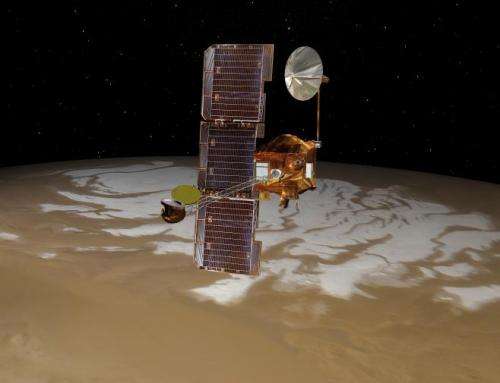Test of spare wheel puts Orbiter on path to recovery

(Phys.org) -- In a step toward returning NASA's Mars Odyssey orbiter to full service, mission controllers have tested a spare reaction wheel on the spacecraft for potential use with two other reaction wheels in adjusting and maintaining the spacecraft's orientation.
After more than 11 years of non-operational storage, the spare reaction wheel passed preliminary tests on Wednesday, June 12, spinning at up to 5,000 rotations per minute forward and backward. Odyssey engineers plan to substitute it for a reaction wheel they have assessed as no longer reliable. That wheel stuck for a few minutes last week, causing Odyssey to put itself into safe mode on June 8, Universal Time (June 7, Pacific Time). Safe mode is a precautionary status with reduced activity.
"We are taking steps to assess the replacement of the troublesome wheel with the spare that Odyssey has been carrying for exactly this purpose," said Mars Odyssey Project Manager Gaylon McSmith of NASA's Jet Propulsion Laboratory, Pasadena, Calif. "If the assessment results are positive, this will put us on a path toward resuming full use of Odyssey."
Like many other spacecraft, Odyssey uses a set of three reaction wheels to control its attitude, or which way it is facing relative to the sun, Earth or Mars. Increasing the rotation rate of a reaction wheel inside the spacecraft causes the spacecraft itself to rotate in the opposite direction. The configuration in use since launch combines the effects of three wheels at right angles to each other to provide control in all directions. The orbiter carries a fourth reaction wheel skewed at angles to all three others so that it can be used as a substitute for any one of them. This spare wheel had not rotated since before Odyssey's April 7, 2001, launch.
Odyssey can also use thrusters to control its attitude. Reaction wheels offer the advantage of running on renewable electricity from the orbiter's solar array, rather than drawing on the finite supply of thruster fuel. They also provide more precise control of pointing, which can enable higher data-rate communications through the orbiter's directional antenna.
Odyssey has worked at Mars for more than 10 years, which is longer than any other Mars mission in history. Besides conducting its own scientific observations, it serves as a communication relay for robots on the Martian surface. NASA plans to use Odyssey and the newer Mars Reconnaissance Orbiter as communication relays for the Mars Science Laboratory mission during the landing and Mars-surface operations of that mission's Curiosity rover.
Provided by JPL/NASA


















